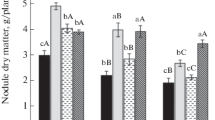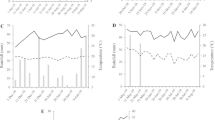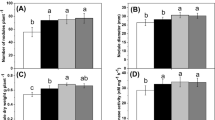Abstract
Association of rhizobia with other plant growth-promoting bacteria (PGPB), such as Azospirillum, have the potential to increase crop yields. This work aimed to assess how Rhizobium tropici and Azospirillum brasilense alone or in combination, affect the growth and yields of common bean grains (Phaseolus vulgaris L.). In a field experiment, R. tropici and A. brasilense were inoculated on seeds, alone or in combination, associated or not with foliar spraying of A. brasilense. Shoot biomass, nitrogen accumulation, thousand-grain weight, and grain yield were evaluated. Application of A. brasilense, on seed or by foliar spraying, and seed inoculation of R. tropici, had an additive effect, increasing biomass and accumulated nitrogen, thousand-grain weight, and grain yield.

Similar content being viewed by others
Availability of data and materials
All collected and analyzed data is presented in the paper.
References
Bahadur A, Singh UP, Sarma BK, Singh DP, Singh KP, Singh A (2007) Foliar application of plant growth-promoting Rhizobacteria increases antifungal compounds in Pea (Pisum sativum) against Erysiphe pisi. Mycobiology 35:129–134. https://doi.org/10.4489/MYCO.2007.35.3.129
Bashan Y, Holguin G, de Bashan LE (2004) Azospirillum—plant relationships: physiological, molecular, agricultural, and environmental advances (1997–2003). Can J Microbiol 50:521–577. https://doi.org/10.1139/w04-035
Braccini AL, Mariucci GEG, Suzukawa AK, Lima LHS, Piccinin GG (2016) Co-inoculação e modos de aplicação de Bradyrhizobium japonicum e Azospirillum brasilense e adubação nitrogenada na nodulação das plantas e rendimento da cultura da soja. Scientia Agraria Paranaensis 15:27–35. https://doi.org/10.1818/sap.v15i1.10565
BRASIL (2009) Regras para análise de sementes. Ministério da Agricultura, Pecuária e Abastecimento. Secretaria de Defesa Agropecuária., Brasília, DF: Mapa/ACS
Bremer E, Janzen HH, Gilbertson C (1995) Evidence against associative N2 fixation as a significant N source in long-term wheat plots. Plant Soil 175:13–19. https://doi.org/10.1007/BF02413006
Bruijn FJ (2015) Biological nitrogen fixation. In: Lugtenberg B (ed) Principles of plant-microbe interactions. Springer, Switzerland, pp 215–224
Burdman S, Volpin H, Kigel J, Kapulnik Y, Okon Y (1996) Promotion of nod gene inducers and nodulation in common bean (Phaseolus vulgaris) roots inoculated with Azospirillum brasilense Cd. Appl Environ Microbiol 62:3030–3033
Carvalho RH, Jesus EC, Souza Filho BF, Fontana A, Straliotto R, Araújo AP (2018) Crescimento e produção do feijoeiro comum sob coinoculação com Rhizobium, Azospirillum e Bradyrhizobium em condições de campo. Cadernos de Agroecologia, Anais do VI CLAA, X CBA e V SEMDF, Brasília-DF, Brasil
CQFS-RS/SC—Comissão de Química e Fertilidade do Solo—RS/SC (2016) Manual de calagem e adubação para os Estados do Rio Grande do Sul e de Santa Catarina. Sociedade Brasileira de Ciência do Solo.
Dourado Neto D, Fancelli AL (2000) Produção de Feijão. Agropecuária, Guaíba
Fageria NK, Melo LC, Ferreira EPB, Oliveira JP, Knupp AM (2014) Dry matter, grain yield, and yield components of dry bean as influenced by nitrogen fertilization and rhizobia. Commun Soil Sci Plant Anal 45(1):111–125. https://doi.org/10.1080/00103624.2013.848877
Ferreira PAA, Silva MAP, Ruffini CA, M, Moreira FMS, Andrade MJB, (2009) Inoculação com cepas de rizóbio na cultura do feijoeiro. Cienc Rural 39:2210–2212. https://doi.org/10.1590/S0103-84782009000700041
Ferri GC, Braccini AL, Anghinoni FBG, Pereira LC (2017) Effects of associated co-inoculation of Bradyrhizobium japonicum with Azospirillum brasilense on soybean yield and growth. Afr J Agric Res 12:6–11. https://doi.org/10.5897/AJAR2016.11711
FAO – Food and Agriculture Organization of the United Nations. (2014). World Reference Base for soil resources. 2014: international soil classification system for naming soils and creating legends for soil maps. World Soil Resources Report 106. Rome: Food and Agriculture Organization of the United Nations.
Fukami J, Nogueira MA, Araujo RS, Hungria M (2016) Accessing inoculation methods of maize and wheat with Azospirillum brasilense. AMB Expr 6:3. https://doi.org/10.1186/s13568-015-0171-y
Gonzalez-Lopez J, Martinez-Toledo MV, Reina S, Salmeron V (1991) Root exudates of maize and production of auxins, gibberellins, cytokinins, amino acids and vitamins by Azotobacter chroococcum in chemically-defined media and dialysed-soil media. Toxicol Environ Chem 33:69–78. https://doi.org/10.1080/02772249109357748
Huergo LF, Monteiro RA, Bonatto AC, Rigo LU, Steffens MBR, Cruz LM, Chubatsu LS, Souza EM, Pedrosa FO (2008) Regulation of nitrogen fixation in Azospirillum brasilense. In: Cassán FD, Salamone IG (Eds) Azospirillum sp.: cell physiology, plant interactions and agronomic research in Argentina. Asociación Argentina de Microbiología, Córdoba, pp 17–28.
Hungria M, Nogueira MA, Araujo RS (2013) Co-inoculation of soybeans and common beans with rhizobia and azospirilla: strategies to improve sustainability. Biol Fertil Soils 49:791–801. https://doi.org/10.1007/s00374-012-0771-5
Hungria M, Araujo RS, Silva Júnior EB, Zilli JE (2017) Inoculum rate effects on the soybean symbiosis in new or old fields under tropical conditions. Agron J 109(3):1106–1112. https://doi.org/10.2134/agronj2016.11.0641
IAPAR, Instituto Agronômico do Paraná (2020). Cultivar de feijão IPR Tuiuiú. https://www.iapar.br/arquivos/File/folhetos/iprtuiuiu/iprtuiuiu.html. Accessed 22 Apr 2020
Jadoski S, Saito L, Prado C, Lopes EC, Sales LLSR (2010) Characteristics of the nitrate leaching in intensive farming areas. Pesquisa Aplicada Agrotecnol 3:150–168. https://doi.org/10.5777/paet.v3i1.1008
Khan MS, Zaidi A, Rizvi A, Saif S (2017). Inoculation effects of associative plant growth-promoting Rhizobacteria on the performance of legumes. In: Zaidi A, Khan M, Musarrat J. (Eds) Microbes for Legume Improvement (pp. 261–276). Springer, Switzerland. https://doi.org/https://doi.org/10.1007/978-3-319-59174-2_11
Lenin G, Jayanthi M (2012) Indole acetic acid, gibberellic acid and siderophore production by PGPR isolates from rhizospheric soils of Catharanthus roseus. Int J Pharma Biol Arch 3(4):933–938
Masciarelli O, Urbani L, Reinoso H, Luna V (2013) Alternative mechanism for the evaluation of indole-3-acetic acid (IAA) production by Azospirillum brasilense strains and its effects on the germination and growth of maize seedlings. J Microbiol 51(5):590–597. https://doi.org/10.1007/s12275-013-3136-3
Munier-Jolain N, Larmure A, Salon C (2008) Determinism of carbon and nitrogen reserve accumulation in legume seeds. CR Biol 331:780–787. https://doi.org/10.1016/j.crvi.2008.07.020
Peres AR, Rodrigues RAF, Arf O, Portugal JR, Corsini DCDC (2016) Co-inoculation of Rhizobium tropici and Azospirillum brasilense in common beans grown under two irrigation depths. Rev Ceres 63:198–207. https://doi.org/10.1590/0034-737X201663020011
Portugal JR, Arf O, Peres AR, Gitti DC, Rodrigues RAF, Garcia NFS, Garé LM (2016) Azospirillum brasilense promotes increment in corn production. Afr J Agric Res 11:1688–1698. https://doi.org/10.5897/AJAR2015.10723
Puente ML, Gualpa JL, Molina LGA, RM, Carletti SM, Cassán FD, (2018) The benefits of foliar inoculation with Azospirillum brasilense in soybean are explained by an auxin signaling model. Symbiosis 76:41–49. https://doi.org/10.1007/s13199-017-0536-x
Puente ML, Zawoznik M, Sabando ML, Perez G, Gualpa JL, Carletti SM, Cassán FD (2019) Improvement of soybean grain nutritional quality under foliar inoculation with Azospirillum brasilense strain Az39. Symbiosis 77:41–47. https://doi.org/10.1007/s13199-018-0568-x
Soares R, Tejo J, Veloso MM, Castro IV (2016). Biological nitrogen fixation by Phaseolus vulgaris. Revista de Ciências Agrárias, 39(4):526–537. http://dx.doi.org/https://doi.org/10.19084/RCA16104
Souza JEB, Ferreira EPB (2017) Improving sustainability of common bean production systems by co-inoculating rhizobia and azospirilla. Agr Ecosyst Environ 237:250–257. https://doi.org/10.1016/j.agee.2016.12.040
Strzelczyk E, Kampert M, Li CY (1994) Cytokinin-like substances and ethylene production by Azospirillum in media with different carbon sources. Microbiol Res 149:55–60. https://doi.org/10.1016/S0944-5013(11)80136-9
Tedesco M, Gianello C, Bissani C, Bohnen H, Volkweiss SJ (1995) Análises de solo, plantas e outros materiais. Ufrgs, Porto Alegre
Vieira Neto SA, Pires FR, Menezes CCE, Menezes JFS, Silva AG, Silva GP, Assis RL (2008) Formas de aplicação de inoculante e seus efeitos sobre a nodulação da soja. Rev Bras Ciênc Solo 32:861–870. https://doi.org/10.1590/S0100-06832008000200040
Wang F, Wang ET, Wu LJ, Sui XH, Li Y Jr, Chen WX (2011) Rhizobium vallis sp. nov., isolated from nodules of three leguminous species. Int J Syst Evol Microbiol 61:2582–2588. https://doi.org/10.1099/ijs.0.026484-0
Funding
This study was financed by the Coordenação de Aperfeiçoamento de Pessoal de Nível Superior –Brasil (CAPES)—Finance Code 001.
Author information
Authors and Affiliations
Contributions
P.E. Lovato and C. R. Lorenzi conceived the experimental design. L.D. Filipini, B.S. Ventura and E. Meyer performed the experiments and the data collection. E. Meyer performed the statistical analysis. The first draft of the manuscript was written by L.D. Filipini and F.K. Pilatti, and all authors commented on previous versions of the manuscript. All authors read and approved the final manuscript.
Corresponding author
Ethics declarations
Conflict of interest
The authors declare they have no competing interests.
Additional information
Communicated by Erko Stackebrandt.
Publisher's Note
Springer Nature remains neutral with regard to jurisdictional claims in published maps and institutional affiliations.
Rights and permissions
About this article
Cite this article
Filipini, L.D., Pilatti, F.K., Meyer, E. et al. Application of Azospirillum on seeds and leaves, associated with Rhizobium inoculation, increases growth and yield of common bean. Arch Microbiol 203, 1033–1038 (2021). https://doi.org/10.1007/s00203-020-02092-7
Received:
Revised:
Accepted:
Published:
Issue Date:
DOI: https://doi.org/10.1007/s00203-020-02092-7




